The Majesty of Borobudur

When we last left off on the Indonesian adventure, my friend Rachel and I had left our comfortable suite onboard Seabourn Odyssey for a two-night adventure to visit Prambanan and Jogjakarta and experience a sunrise atop the 9th century Buddhist temple of Borobudur, the largest Buddhist temple in the world and a UNESCO World Heritage Site.
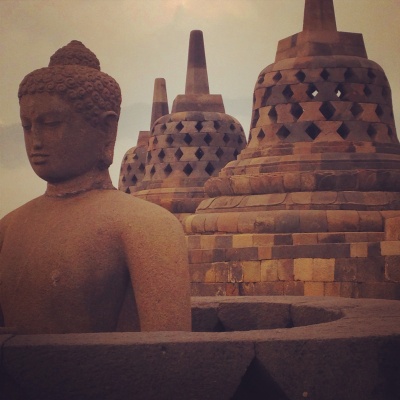
We awoke at 4 am in our basic but comfortable room at the Manohara Resort Center of Buddhist Study as we were scheduled to meet our guide Koko at 4:45 am to ascend. I had slept well but lightly as we had watched a special on crocodiles the night before while eating our room service Thanksgiving dinner and I had dreams about being eaten alive (possibly also exaggerated by reading too much about the Komodo dragons we would visit the following week).
The main draw of the hotel is that they are on the temple grounds so they offer pre-opening access to their guests as well as to others willing to pay a small fee for the privilege of using their grounds as the entry point. The temple complex remains relatively secure within a larger access ring due to past terror threats. In the 1980s, part of the temple was damaged by extremist group bombing. In recent months, the structure has been threatened by ISIS who believes that the statues are offensive to extreme Islamic believes against idolatry.
The lobby was abuzz when we met our guide as several cars and vans were arriving with outside guests ready to experience a famous Borobudur sunrise. It was very dark as we left the resort through a back gate. The hotel issued each of us a small flashlight to illuminate our way and we set out on a back path to reach the temple which was about a five minute walk. Once we arrived, we began ascending to the top.
Borobudur is a terraced temple. Built for a worship through movement throughout the temple, each of the three terraces completely circles the structure which gradually narrows by layer. Structurally it looks like a flat-topped pyramid. The terraces are separated by flights of steep narrow steps. They were too small to put my entire size 10 foot onto and the stones were sometimes weatherworn and thus rounded off to create an uneven surface. The elevation of each step is such that one must lift the leg and hoist up a bit to the next step might be 12-15” high. There are no railings so the narrow and steep combination requires a bit of balance and coordination to maneuver safely in the dark.
After a few minutes of climbing, we reached the top terrace and staked out positions to watch the sunrise. I found a good spot in front of one of the carved stupas (bell shaped encasements that each hold a Buddha statue) and set up my GoPro HERO 4 on a small tripod to shoot on a time lapse. Rachel and our guide sat on a ledge on the terrace wall behind me. There are a total of 72 stupas containing Buddhas on the top terrace (there are a grand total of 504 Buddhas within the overall structure).
The terrace was not crowded by some tourist standards (for example, the hundreds who crowd the fields and outer walls in front of Angkor Wat at pre-dawn each day) but there was certainly a healthy amount of traffic for a weekday morning in the rainy season (I would estimate there were over a hundred visitors on the terrace with us). As a side note, I found it incredibly distracting in such a spiritual place that many were scrambling around, paying no mind to those of us who had staked out spaces to shoot (at one point, a man stood in front of my camera for at least a minute while fiddling with his iPhone). Others were carrying on conversations. If I visit again at sunrise, I will bring headphones!
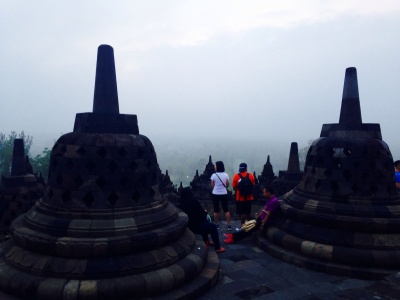
We unfortunately had picked a very overcast morning for our visit (a hazard, especially in the rainy season) so the sunrise was not as spectacular as we had hoped for. While we had a clear view and could see the volcanos on the horizon (including active Mount Merapi), the sun stayed behind the clouds so our main view was of changing light levels.
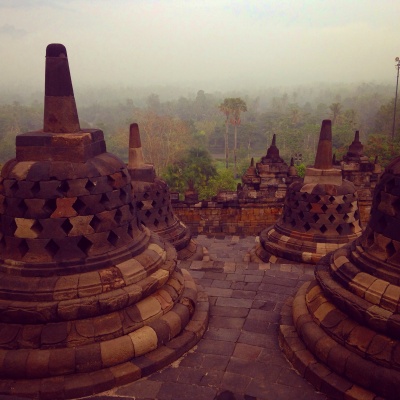
Nonetheless, the early admission meant we were now at the top of Borobudur long before the park would open to others. Many of the sunrise visitors began to make their way back down (perhaps having visited the day before?) so we had a relatively private experience as we began to explore the terraces and many Buddhas.
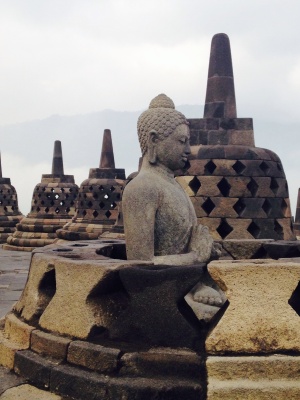
Some of the stupas are missing their statues completely. Others are headless as they have often been decapitated by Western collectors who now display the heads in galleries (such as The British Museum in London). The Buddhas can be found in five different mudras (or hand positions) and the positioning of these is said to be symbolic. Many tourists will try to reach through the small perforations on the stupas to “touch the hand of Buddha” as this is said to bring great luck to an individual. (Yes, I did!)
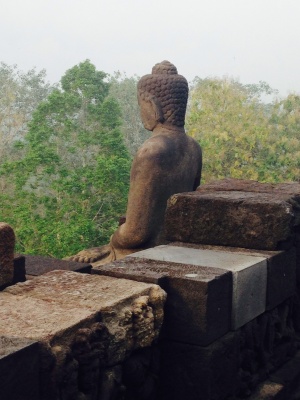
Devout Buddhists show their respects at Borobudur by fully circling each of the terraces, thought to represent the spirit’s ascension through the various levels of consciousness – the world of desire, the world of forms, and the world of formlessness. Because we started at the top, we walked the temple backwards.
The three terraces are interlaced with corridors and staircases that include over 2,500 carved relief panels telling religious tales and documenting day-to-day Javanese life in the era. I was amazed by the intricacy of the stonework. The preservation efforts on the temple have been extensive with structural reinforcement to prevent further earthquake damage and more recent years, clean-up from volcanic eruptions.
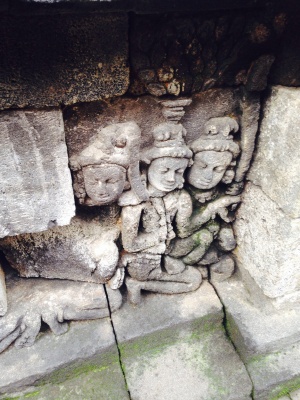

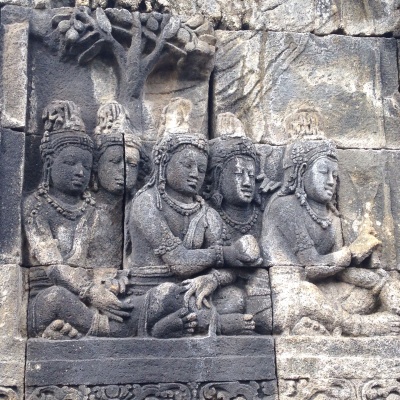
All in all, we had over two hours to explore the Borobudur although we started to encounter crowds on the lower terraces as they began to arrive and ascend. By the time we reached the bottom and made the slow walk back to the Manohara, many tour busses were arriving at the temple complex and we encountered two different large clusters, each taking a group picture in front of the structure. Meanwhile, storm crowds were brewing on the horizon and the air was thick with humidity.
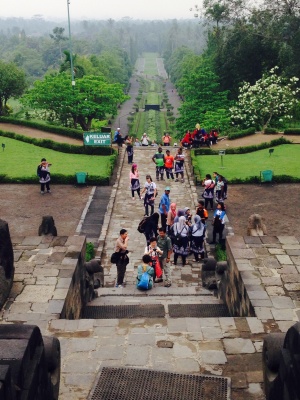
As we approached the back gate of the resort, we were suddenly approached by a group of sellers (postcards, small statues, puppets, kites – all the usual bric-a-brac). Rachel negotiated with a couple for things she wanted which in turn brought more of them out of the woodwork.
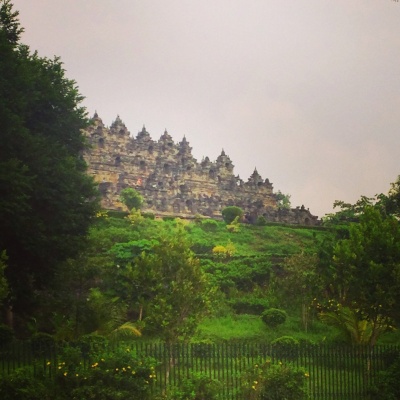
Once back on the temple grounds, we enjoyed a buffet breakfast and then returned to our room to shower before the long ride back to Semarang. The shower was one of the best I ever took – I was caked in sweat mixed with stone dust and it felt wonderful to wash it all away and begin anew.
As we left the hotel, the parade of mini-buses from our ship began to arrive. Those who chose to take the ship’s tour (as I understand, over 200 passengers) would not have the experience of the sunrise or the crowd-free visit. I would later discover that they only spent about an hour at the temple itself, a long trek for the considerable distance each way.
As we made the drive back to Semarang, it began to rain again. I was glad to have skirted it. We arrived back to the port before lunchtime. We boarded the ship to eat lunch but then made our way back off to explore the vendors set up outside the port (where we discovered many of the same bric-a-brac goods for lower prices than what the temple sellers offered.
The port facilities were small but brand-new and contained a couple of nice treats for ship guests (and crew). One was a small zone with free wifi (this is where we found many of the crew members enjoying some time off the ship) and the other was a small foot reflexology set up. For $10, one could enjoy an hour of reflexology. Although it was good, it was by far NOT the best massage we had on the trip (that honor would go to the spa in Surabaya) but it was the creepiest. At one point, I caught Rachel’s masseuse slowly inching her skirt higher and higher while working his way up her leg, winking at his colleagues as he did (her eyes were closed so he must have assumed no one was watching). Definitely out of bounds for foot reflexology. I shot him a raised eyebrow look and he quickly moved her skirt hem back and went back to her feet.
The big question many of our fellow passengers asked – was the extra cost of the two day tour worth it? Yes, absolutely. A planned itinerary like this is ideal for individuals with time limitations – a cruise ship port stop or quick break in a longer itinerary. I was told that many will fly in to Jogjakarta from Bali or Jakarta to experience the same tour.
While we gave up one night on the ship (which was a nonrecoverable cost), we also had a much more in-depth experience with the two central Java temples than our shipmates did. The offered itineraries on Seabourn did not cover Jogjakarta or Prambanan at all. Given the relatively new Seabourn and UNESCO World Heritage partnership, this surprised me greatly. The time they spent at Borobudur was less extensive than ours. We had the ability to enjoy these all relatively crowd-free due to how our itinerary was planned out. And we were back on board in Semarang to still enjoy an afternoon by the pool while half of the guests were off the ship.
I believe in splurging a bit when I’m visiting a more remote part of the world where I’m not sure I will easily get to again. This experience exceeded my expectations for this kind of side adventure tour. The accommodations were certainly not as posh as the ship (there was an Aman hotel down the road from the temple resort should one wish to splurge) but I can give up luxury when the experience calls for it.
That said, I also believe that without the tight time constraints we were under, much of this could be done a la carte. The resort and sunrise pass can be directly booked on the internet and Indonesia has an abundance of car/driver or car/driver/guide services available for booking through many services at all price points.
Would I recommend a trip to Indonesia just to see Borobudur?
Absolutely. I found it to be the most stunning temple I’ve visited to date (and I’ve been to quite a few!) and one that is greater danger of destruction than others – due to volcanos, earthquakes, and heavy tourism. The site is already planning wooden stairs (such as those sites like Angkor Wat have already installed) to prevent further stone wear and that will in turn change the overall appearance of the site. Wear on the relief panels is occurring from heavy contact from humans and environmental factors (although I found them to be in quite good condition considering this). But most of all, I believe that visits to both Prambanan and Borobudur are important completion marks for anyone who has an interest in Southeast Asian temple complexes, Hinduism, and/or Buddhism.
Borobudur is one of my favorite places on the planet. I am always stunned by the beauty, the peace, and the way I slip so easily into quiet contemplation. Thank you for highlighting it.
Great Post and Nice Article.All of the Photos are so good.I like it.Thanks for sharing.